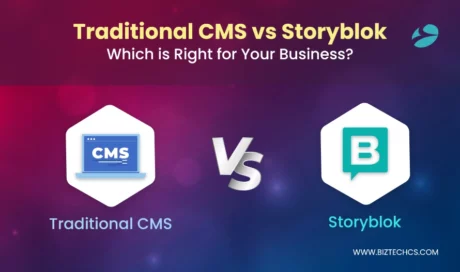3218
5 Steps to ADA Compliant Website [Checklist Inside]
21 Sep, 2020
9 min read
3218
21 Sep, 2020
9 min read
![5 Steps to ADA Compliant Website [Checklist Inside]1 5 Steps to ADA Compliant Website [Checklist Inside]1](https://www.biztechcs.com/wp-content/uploads/2020/09/5-Steps-to-ADA-Compliant-Website-Detail-page.png)
So, what’s ADA?
ADA stands for Americans with Disabilities Act. It is a law passed in 1990 to avoid discrimination against people with physical limitations. According to this law, it is imperative for every public sector business to make their services/products compatible and accessible for people with disabilities.
We have seen the flat and ramped entrances on the buildings, designated disability parking spaces. All these are the exemplary fruits of ADA compliance. Considering the use of the internet in our daily lives, the US Department of Justice, in 2010, passed the Americans for Disabilities Act Standards for Accessible Design, making it necessary for websites to be easily accessible for the disabled.
Let’s see what exactly it means for a website to be ADA compliant and how you can achieve it.
You might be thinking, what difference would a website ADA compliant make? For you and me, it may not be any different but for the disabled, it can be troublesome to access the website tools and services. For instance, a person with color blindness may have difficulty accessing the website with green and gray contrast. Thus, ADA compliance for websites mandates businesses to provide auxiliary aids and services to people with disabilities. Though there are no enforceable ADA legal standards for website accessibility, there are some trusted standards that allow the world to follow web-based solutions such as World Wide Web Consortium or W3C. The website accessibility guidelines are known as WCAG.
Companies in the US are not legally bound to apply ADA to their websites, however, they can still get stuck in lawsuits. But that should not be the actual reason to have an ADA compliant website. So, why does it matter?
If you’re wondering if it is worth looking into, these reasons may convince you.
There are nearly 61 million people with disabilities in the U.S. alone, which means that about 26 percent of the population there has one or the other disability. Consequently, making ADA-compliant websites means you get to understand and target these 61 million people as well.
WCAG provides accessibility to screen readers, and these readers crawl your website pages similarly to search engines.
You will not only get more customers but they will know how thoughtful your business is which will increase their and others’ trust in your brand.
With quick navigation and easy access, everyone impaired or not will be able to find the information easily.
Keep your pages updated to be at least grade A compliant. If you want to escape the legal expenses of having the ADA non-compliant, it is better to make the appropriate improvements to your website now.
Related: ADA Compliance: The Need of the Hour
Convinced? Well, I am!
Okay, let’s move further with the ADA website compliance checklist!
Basically, government agencies and contractors are obliged to abide by website accessibility guidelines under Section 508 of the Worker Rehabilitation Act. Though it’s different from ADA, it provides insights into making websites accessible for disabled people.
Here’s the checklist for an ADA compliance website:
✔️Every image, video, clip, and non-text element should have an alt tag.
✔️If the image is a link, add the alt tag showing the description of the link and the graphic.
✔️The video should consist of a caption and a description.
✔️Create a link to the video instead of embedding it on the website.
✔️Video download links should be added.
✔️Web page information conveyed with colors should also be available without colors.
✔️Don’t override user-defined stylesheets.
✔️The tags should have an alt attribute.
✔️Data tables should have appropriate column and row headers including tags.
✔️Tables used strictly for layout purposes shouldn’t have header rows or columns.
✔️Ensure the page doesn’t contain repeatedly flashing images and strobe effects.
✔️Provide a link to a disability accessible page to download plug-ins.
✔️A scripting language like JavaScript should provide functional code that can be read by assistive technologies, or in an alternative way.
✔️When form controls are text input fields use the LABEL element.
✔️Use the title attribute in absence of text.
✔️Include any special instructions within field labels.
✔️Make sure that form fields are in the logical tab order.
✔️Include a ‘Skip Navigation’ button to help those using text readers.
✔️Choose layout elements carefully.
First of all, find a developer who has experience with platforms and frameworks that your website uses. Next, ask them about ADA compliance and how their design and development workflow addresses accessibility. If the company provides responsive website design, that means it has already covered most of the elements of the ADA compliance website. And if they ensure you that they know the complexities of developing an ADA compliant website, then the recommendation is to partner with that company.
Check out our case study of an ADA compliance website: Breyting Community Roaster
Next step, audit your website code. The tools used for testing the code will crawl, check, and identify every element/area that doesn’t meet web accessibility standards for ADA compliance. The result will provide you with a list of work required and an idea of the budget. Each website configuration varies and so does the ADA audit cost. What if your website is fairly compliant? You will have to put in fewer efforts and resources.
You have the reports in your hand. Now, go to your development/design partner and ask about the overall level of effort it will require to revamp or design your website from scratch. A good tech partner will provide you with an estimate by checking on the requirements, budget, timelines, proposed deliverables, and some compliance expectation management.
It might happen that the task list is huge and so the approach is not feasible for your company. Looking at the brighter side, you will know where you sit with ADA compliance and can plan for the future. Or even update your website in installments.
Once the project requirement is on the track, it’s time for website development. The development team will start working on the various deliverables and update you about the changes that will affect user experience positively. While in development, check out for these common ADA issues:
ADA website compliance is not a one time task. As eCommerce features keep updating, the compliance standards change and thus must be followed and implemented periodically over time.
From offline businesses to online websites, every business owner including you should anticipate making their business ADA compliant to promote inclusivity. If you need any help in making your website ADA compliant, feel free to contact us!

Storyblok
21884
By Devik Gondaliya
02 Apr, 2025

Storyblok
22859
By Devik Gondaliya
01 Apr, 2025

Storyblok
23620
By Devik Gondaliya
27 Mar, 2025